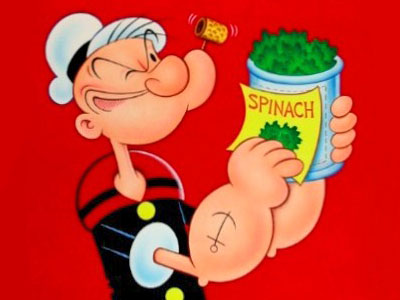
Birthday greetings to Popeye the Sailor Man, who showed up in Elzie Segar's newspaper strip, Thimble Theater, 75 years ago today. The spinach-munching, Bluto-punching gob would later take over the whole feature…and Segar's version (who never punched Bluto and only occasionally munched spinach) would be almost forgotten in favor of the Popeye of the Max Fleischer cartoons. What Segar put on paper was one of the five-or-so greatest comic strips ever done but unlike many who feel that way, I also have affection for the cartoons and for the strips and comic books done by Segar's successor, Bud Sagendorf. That's a Sagendorf Popeye I put up there.
When the Fleischer crew got hold of Popeye in 1933, he was a pretty well-rounded character with a personality as well-defined as his forearms and a certain amount of stardom. The cartoons though gave Popeye two things that Segar, working in pen and ink, had been unable to give him: A great theme song and the perfect voice. Whenever a print character is animated, there's always at least a little controversy over what he or she should sound like. I recall the disappointment of some of my friends when the first Peanuts cartoons (the Ford commercials) were voiced by genuine little kids with bland little kid voices, rather than the smarter, better-defined voices my friends were hearing in their heads. And when I worked on the Garfield cartoons, I sometimes encountered someone who insisted that in selecting Lorenzo Music, Jim Davis had woefully miscast his own creation.
But can you imagine Popeye with anything but that perfect sound? It was originated by a performer named William Costello who billed himself as "Red Pepper Sam." After a fistful of cartoons, he made the mistake of mentioning the "r" word ("r" as in "raise") and was quickly booted. After a few failures, the job went to an artist in the studio named Jack Mercer who matched what Costello had done and went him one better, adding nuance, a wider range of emotions and those wonderful muttered asides. Mercer owned the role until his death in 1984.
Credit for creating this American icon goes to Segar, but one should note an "assist" by men like Mercer, Sagendorf and others who made the cartoons. Sadly, they have all departed this planet, and Popeye's current creative health is a bit uncertain. Three or four times in my life, I've been called in for chats about new Popeye projects and all three times, everyone seemed so worried about him punching anyone, and to a lesser extent about him having a pipe in his mouth, that the projects seemed doomed. I am all for not presenting bad role models for the kiddies but you can carry Political Correctness to the point of draining all humor, and all that is special from a character. Popeye used to always say, "I yam what I yam," and I wish the folks who currently control the property would listen to the guy. He knows what he's talking about.